When Cassey Ho’s phone erupted with notifications, she couldn’t believe what her followers were posting: Taylor Swift was wearing the Popflex Digital Lavender Pirouette Skort in her #ForAFortnightChallenge video.
In just 15 seconds of screen time, Swift created retail magic—the skort sold out in 15 minutes flat. This viral moment demonstrates what every marketer dreams of: authentic referral power. While few brands can secure a Taylor Swift appearance, your business can create its own success through strategic referral links—unique URLs that track where customers come from and drive word-of-mouth marketing.
The Popflex skort saw a 700 percent sales lift as every color and size vanished, triggering thousands of pre-orders. Your brand can capture similar energy with a referral link program that effectively rewards advocates and monitors traffic sources. Let’s explore how these specialized tracking URLs can transform your word-of-mouth strategy.
What is a referral link?
In a nutshell, a referral link is a unique URL brands give to their customers so they can share it with their friends, family, and audience. It helps brands track which advocates send them new leads.
Think of referral links as a digital reference. It can be likened to your trendy friend saying, “Hey, I got my soft bob cut done at the Hair Den, and they do nails! Here’s their number.” But instead of passing over a random napkin with their number on it, they give you a custom URL.
The owners of the Hair Den know that your friend sent you to their salon without you having to tell them. Referral links are a key piece to referral programs. They help brands understand where their new leads are coming from and which customers should receive a reward for their referrals.
The benefits of referral links: easy to track and optimize program performance
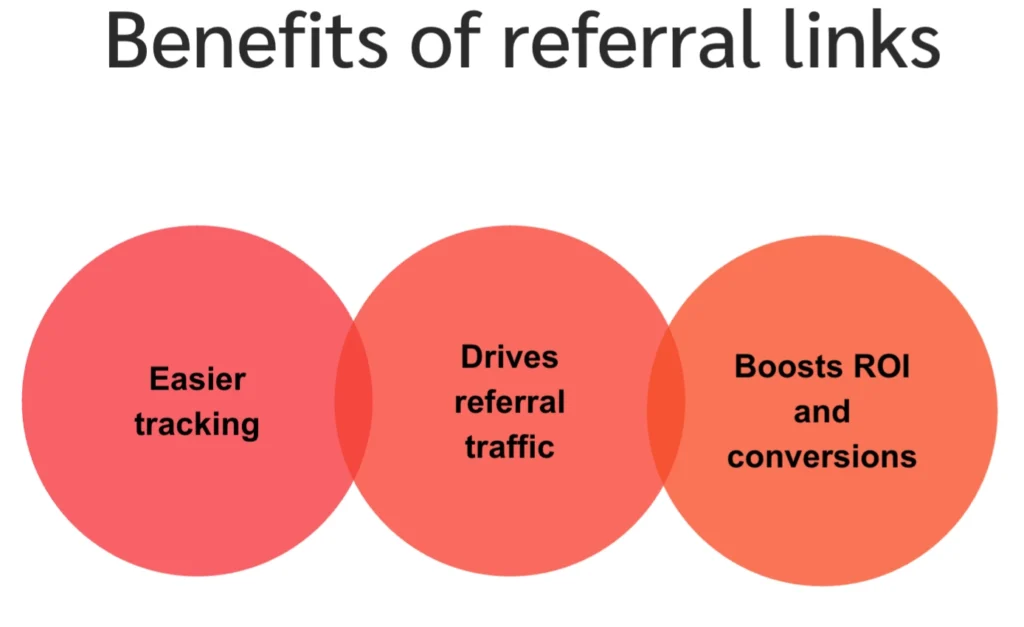
The benefits of using referral links to track programs
If you want to know who is positively promoting your brand and sending new traffic your way, it’s essential to give your customers referral links.
Here are a few reasons why referral links are important.
Makes tracking referral programs easier
One of the biggest challenges brands face in running a referral program is tracking. Luckily, referral links make this process much simpler.
Every link is unique to individual referrers, so you can easily track where each new referral came from. This process removes the guesswork and ensures you fairly reward the right people.
Drives referral program traffic
If you’re looking for a website traffic boost, referral links are the way to go. These URLs directly point to your referral program, helping increase leads and brand awareness.
Boosts ROI and conversions
Your primary goal in any marketing strategy is to drive revenue. Referral programs and links naturally lead to more ROI and conversions.
Referral programs are a quick way to gain interest from new customers. Your customers already know, love, and trust you. And because their friends already know, love, and trust them, their recommendations are worth their weight in gold.
Your advocates become your biggest cheerleaders, taking the task of reaching more customers and converting them off your plate.
Referral codes vs. referral links: which is better?
Should you use a referral code or referral link? That is the question.
To dig into this question, let’s define referral codes. These codes are unique letters and numbers tied to your referrers to help you determine which new customer was sent via a referral.
For example, Uber has a referral code in its app, where referrers get a $5 reward and new users get a minimum of $2 off the first three rides.
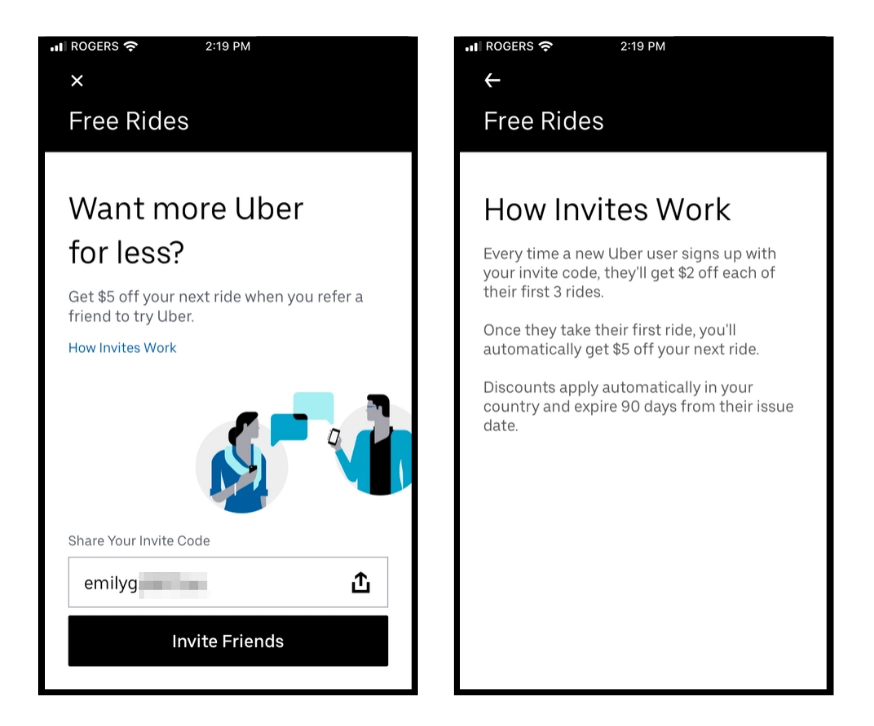
Uber uses a double-sided referral program to entice new and old customers to book more rides
The upside of codes is that they’re generally easy to use and remember. On the downside, they can be harder to track than referral links. Since URLs are used at various touchpoints, data is tracked from the first to last click, which is extremely helpful for marketing attribution.
In addition, a referral link can be easier for customers to use than codes. They usually click on the URL, and the discount coupon is automatically applied during checkout. This ease-of-use leads to less cart abandonment.
How to create a referral link
You don’t need to be a tech whiz to create a referral URL. A few simple steps, and you’re on your way to a working link.
Here’s the difference between manual and automated link generation:
Manual link generation
You can manually generate referral links through the backend of your website. Fair warning: it can be tricky and requires some technical know-how. Plus, manual creation uses more steps, which can be time-consuming.
Steps for manually creating links:
Step 1: Go to your website and choose the page you want your traffic to go to.
Step 2: Depending on your website, you will access it from one of these options:
- Theme files
- Plugins
- Database
- Admin files
Tip: If you’re unsure which one you’ll modify, contact your website administrator.
Step 3: Add a new UTM parameter (like the referrer’s name) to the end of the link. This might look something like: www.yourwebiste.com/signup?ref=cassie. In this example, the UTM parameter, sigunup?ref=cassie, makes it easy to determine that Cassie sent new leads to your pages.
Step 4: Store the UTM parameters in a cookie or session. This helps the UTM parameter stick to links as users browse your website.
Step 5: Create referral link tracking by setting up Google Analytics to gain insights on individual link performance.
Step 6: Once data becomes available, add it to a spreadsheet. Ideally, this spreadsheet will contain extra information, like who the link belongs to, so you can easily track performance.
Automated link generation
To avoid the headache of manual link tracking, consider generating automated links.
Referral solutions like Advocate by impact.com creates unique links for each customer advocate without requiring you to go into the backend of your website and risk breaking something.
No one wants to promote a weird-looking link, and luckily, automated links are often more aesthetically pleasing than manually created links.
Vanity links, or shorter, branded links, offer more personalization. They use your advocate’s name or social media handle in the URL. The other benefit of referral platforms is that they automatically provide in-depth insights, like traffic and performance. There’s no need for additional insights from Google Analytics or tedious spreadsheets.
Advocate by impact.com automatically generates links for all referrers. However, you can customize these by turning them into vanity URLs.
Steps for creating vanity links in Advocate by impact.com:
Step 1: In the left navigation menu, select Participants.
Step 2: Search for and select the name of the participant whose code you want to change. This opens their participant profile.
Step 3: Select the Codes and links tab below the participant’s program info.
Step 4: Track participant data with Advocate by impact.com’s advanced and automated reporting.
How to promote referral links and codes
Creating referral links without promoting them is like having a map with no destination. You could have the best offers for your customers, but zero promotion will lead customers and your brand to the wayside.
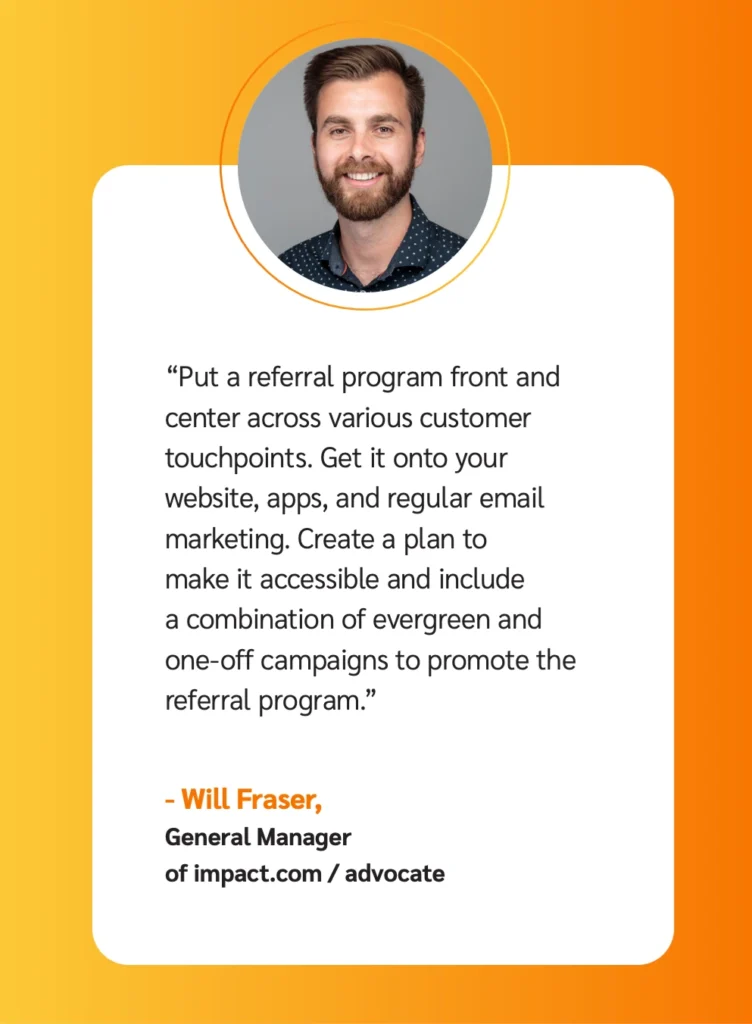
Use the strategies below to create a well-structured referral promotion strategy.
Social media/influencers
While you don’t need to work solely with social media influencers to promote your brand, they do have an engaged following that hangs on to their every word. A word-of-mouth recommendation from a well-connected creator can drive real customer engagement.
Lifestyle influencer Ailynns shared a post on Instagram offering her followers 15 percent off Bowlero on St. Patrick’s Day when they use her unique referral code.
The post feels genuine. Ailynn is simply sharing a fun night out with her family, which makes the promotion feel less salesy and more like a recommendation from a best friend.
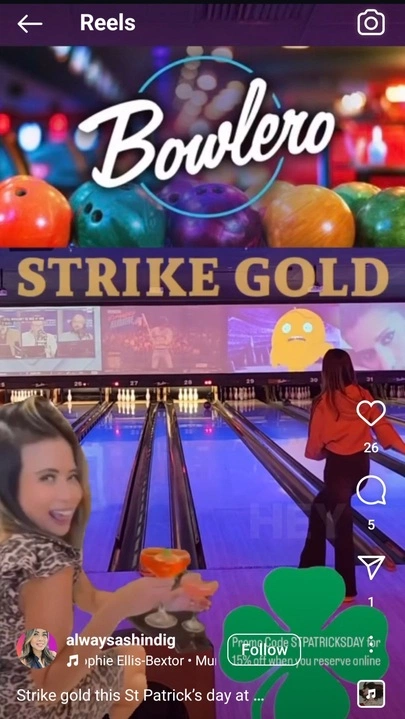
Ailynn shares a fun night out with her family at Bowlero
Emails and newsletters
If you already have a large newsletter following, promoting your referral program there seems like a natural fit. Highlight the key benefits and steps succinctly.
The Body Shop’s newsletter clearly shows the 3 steps in referring friends and family. The email is concise and includes bold colors and imagery associated with its brand’s identity.
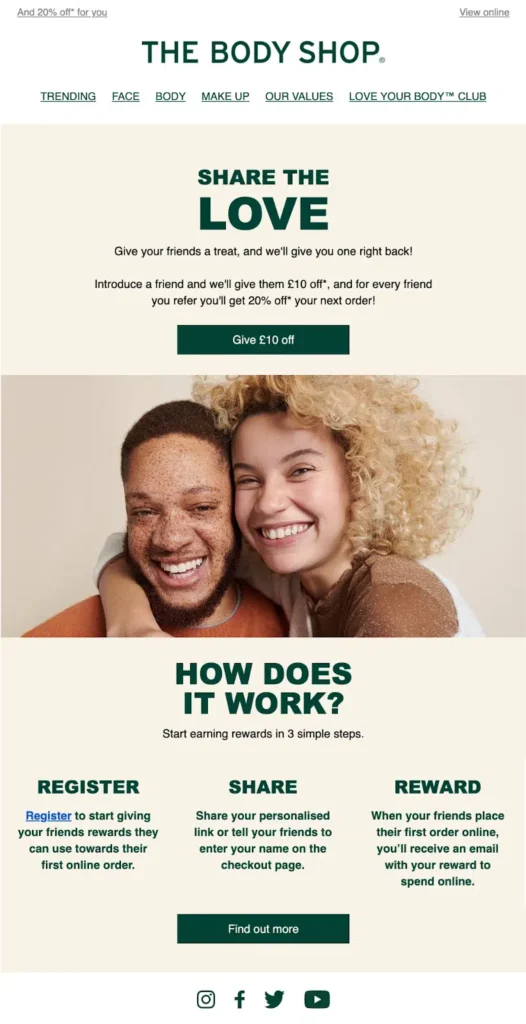
The Body Shop’s newsletter promotes its referral program with concise words and on-brand images
Post-purchase prompts
When new customers feel good after a purchase, they will likely share their experience. Sweeten the customer’s buying experience with a special discount sent to their email or on the post-purchase page.
For instance, bag apparel brand Kipling has a post-purchase pop-up offering customers 15 percent off their next purchase. This enticing offer helps retain customers and lock in new ones.

Kipling has a post-purchase pop-up offering customers 15 percent off their next purchase
In-app prompts
In-app prompts can be a great way to get new participants into your referral program.
These pop-up messages raise awareness, driving curious advocates to check out your program. With any luck, your current users will share the link across various social media channels and invite their friends and followers to join them on your app.
Instacart has an ecommerce referral program that lets customers share referral links directly within the app. The app prominently features the offer with a bright “Give $10 Get $10 link at the top of the main menu, ensuring that it’s one of the first things users see when they open the app.
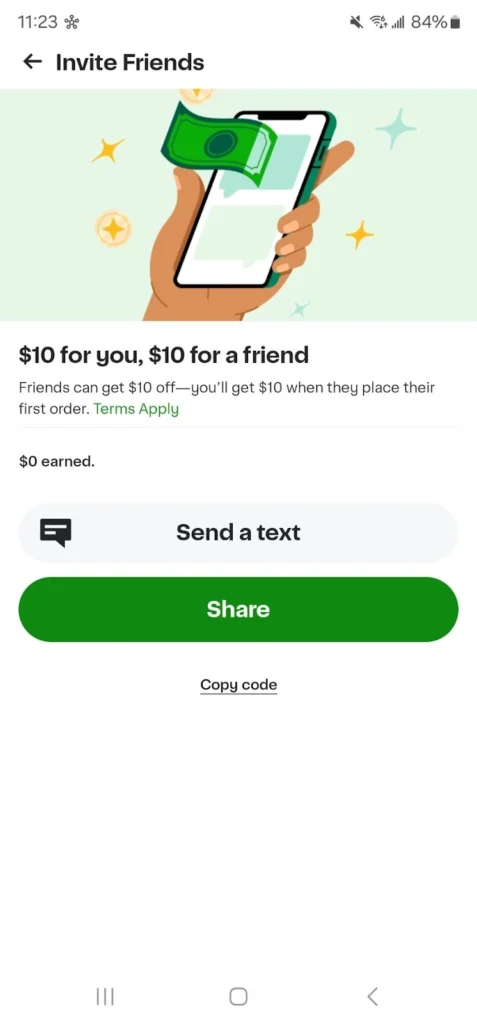
Instacart’s app prominently features a “Give $10 Get $10 link at the top of the main menu
Place it onto the website menu or footer
Don’t bury your program on your website. Place it in a highly visible area that will grab customers’ attention.
Blink Health makes it easy for users to find and engage with their referral program by placing it directly in the app’s main menu. Customers naturally encounter the program during app usage, increasing participation with minimal effort.
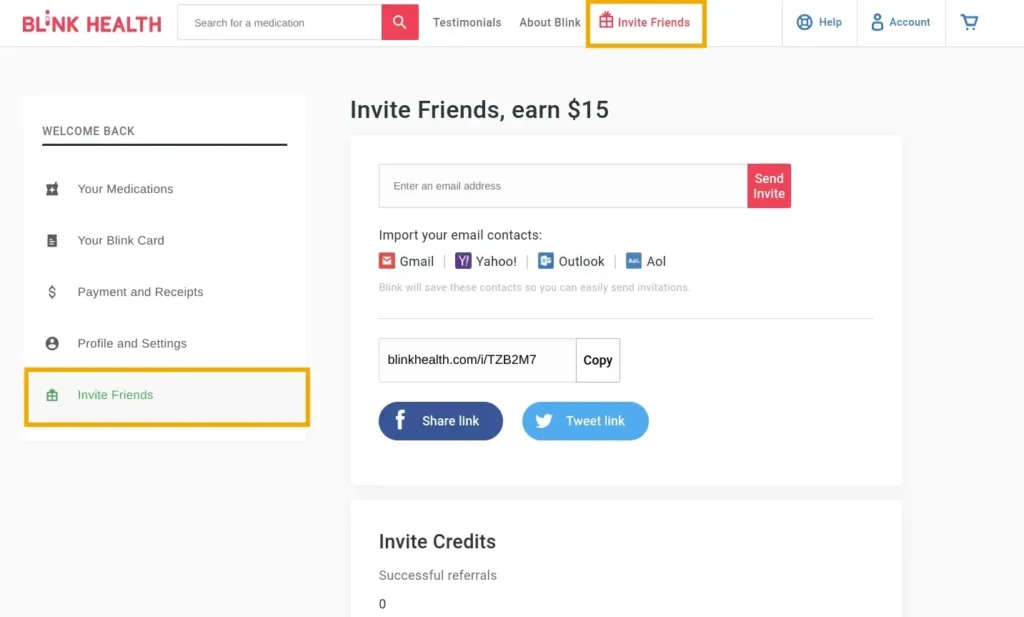
Customers can easily find Blink Health’s referral program on the website’s main menu
Troubleshooting common referral link issues
Even the best-designed referral programs encounter obstacles. Here are solutions to the most common referral link challenges:
Fix broken tracking connections
If your referral links aren’t properly recording conversions, verify your tracking parameters are correctly formatted and that cookies are being set properly. Check that ad blockers aren’t interfering with your tracking scripts.
Resolve attribution conflicts
When multiple touchpoints claim credit for the same conversion, implement a clear attribution model (first-click, last-click, or time decay) and communicate these rules transparently to your advocates.
Address low click-through rates
If referral links aren’t getting clicks, test different incentives, simplify your sharing process, or create more compelling call-to-action messaging that clearly communicates the value proposition.
Combat referral fraud
Implement verification steps like requiring minimum purchase amounts, setting reasonable reward thresholds, and using IP tracking to identify suspicious patterns that might indicate self-referrals or gaming of the system.
Manage expired or invalid links
Set up automatic redirects for outdated links, implement a link management system that alerts you to broken links, and create a simple process for advocates to request updated links.
Overcome sharing hesitation
If advocates seem reluctant to share links, consider offering tiered rewards, providing sharing templates, or creating exclusive “members-only” benefits that make the referral feel like providing access to something special.
Choose the right software for tracking referral links
Referral links are the bricks that build a solid foundation for your referral strategy. The best way to ensure your house doesn’t collapse is to use automated tracking to identify weak spots. This way, you can strengthen your structure, bringing in more revenue and customer engagement.
Dedicated referral software like impact.com grows with your referral program—you can quickly scale without pouring hours into manual tracking. With Advocate by impact.com you can create automated unique URLs, track in real time, automate reward payouts, and more.
Ready to take the leap into advanced referral tracking? Contact Advocate by impact.com for a demo today.
Want to learn more about how customer referral and loyalty strategies can grow your business? Check out these resources:
- How to win back lost customers: 7 marketing tactics that rebuild customer loyalty [blog]
- 5 successful ecommerce referral programs and why they work [blog]
- How to switch to a new referral platform in 6 easy steps [blog]
- Top 6 customer referral marketing trends your brand can leverage in 2024 [blog]
- 7 referral marketing strategies to grow your retail business [+stand-out brand examples] [blog]
- Turn delighted customers into revenue-driving advocates [ebook]
- More than a pop-up: Building a customer referral program that scales [+ the tech that drives it [blog]
FAQs:
A referral link is a unique link you provide to your customer advocates. These links make it easy to track traffic, so you get a better idea of which referrer sends you qualified leads. Understanding who sends you new customers makes rewarding them for their efforts easier.
A referral link points to your website but contains a code tied to your each referrer so you can identify them. An example of a referral URL looks like this: www.yourwebiste.com/signup?ref=cassie
You can manually create a referral link by creating unique URLs on the backend of your website. You can also use a referral tool, like Advocate by impact.com, to automate link creation—a much quicker option.






